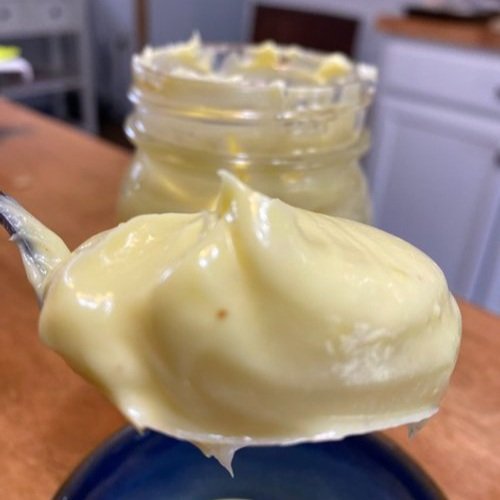Homemade Mayonnaise with Lard!
Homemade Mayonnaise with Lard
The problem with most homemade mayonnaise recipes is that they can produce a rather runny result. Since mayonnaise is basically a blend of oil and vinegar emulsified together then it is logical that your home made spread is going to take on the nature of the oil that is used to make it.
Most recipes use some kind of vegetable oil as the main ingredient, and most vegetable oils are in the form of a liquid at room temperature, so unless you use a thickening agent (which is how store bought mayo - made with soybean oil- is made) then you will end up with quite a runny result!
In the following recipe I switched out half of the vegetable oil for lard and the results were king!! Not only do you get a thicker, creamier spread but because its now made with 50% lard its actually healthier too!
Homemade Mayonnaise With Lard.
Recipe
-
1/4 cup pasture raised lard (melted)
1 + 3/4 cup avocado oil
2 egg yolks
2 tablespoons lemon juice
1 tablespoon white wine vinegar
1 tsp mustard powder
1 tsp sea salt
1 tsp honey -
Melt your lard and blend together with the avocado oil and set aside. ( I like to do this in a pyrex jug that i can later use for pouring the oil)
In a mixing bowl (or stand mixer) whisk together the egg yolks, salt, vinegar, lemon juice and mustard.
Slowly, starting out with drips of oil slowly stream the blended lard and avocado oil into the egg mixture. Keep mixing constantly as the mixture is slowly added. Once the emulsion starts to form the mayonnaise will start to form and the oil can be added a little quicker.
Add honey to taste
Transfer into an air tight container and keep in the fridge for upto 2 weeks.
-
Your mayonnaise flavour is going to be determined by the oil blend used plus the vinegars.
Avocado oil and light olive oil will not add much flavour so you will taste the vinegar more. Full strength olive oil can have a powerful taste however so if you prefer this you can switch out the avocado oil for olive oil.
Lard is used to give the mayonnaise more thickness at room temperature. If you do not have lard on hand the same effect can be used with an oil like coconut oil.
Lemon juice and vinegar both bring acidity to the mayonnaise. Lemon juice will give a fresh more light flavour to your end result where as white wine vinegar or other vinegars will give a more traditional flavour.
Different vinegars to try are malt vinegar, distilled white vinegar, balsamic vinegar and even red wine vinegar.
Salt, mustard and honey are both seasoings and should be used ‘to taste’
I have a few thoughts on the idea of using other animal fats to make lard however I would caution anyone about the idea of using fat that comes from cooked meat such as bacon or roasted joints. I’ve seen a few articles online about the joys of ‘Baconnaise’ and ‘Duckonnaise’ and while using these meat drippings might offer a wonderful flavour to the end result, don’t fall into the trap of thinking it’s just the same as lard….here is why.
Lard is rendered at a very low temperature over a long period of time. It is filtered for its impurities and once bottled and set, this single ingredient product has an amazing fat profile. It is actually lower in saturated fat than butter, contains no trans fats and is loaded with chlolesterol reducing omega 9’s.
With other meat drippings and especially cured meats like bacon, cooking at a high temperature causes a chemical reaction called the Maillard reaction to take place. This reaction results in the formation of compounds called AGE’s and HCA’s which have been linked to increased risk of cancer. So in my opinion, I rather go for the beautifully white and pure jar of lard over the stove top jar of bacon grease, even if it does seem frugal!
If you have tried this recipe or going to give it a go, leave me a comment below… I would love to know what combinations of oil and vinegar you like!

